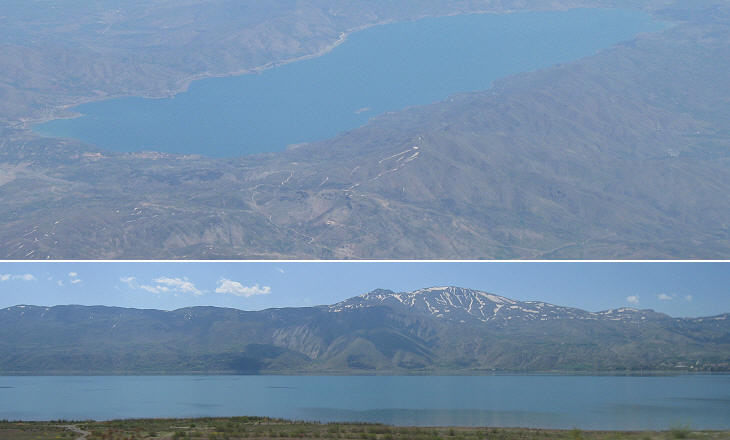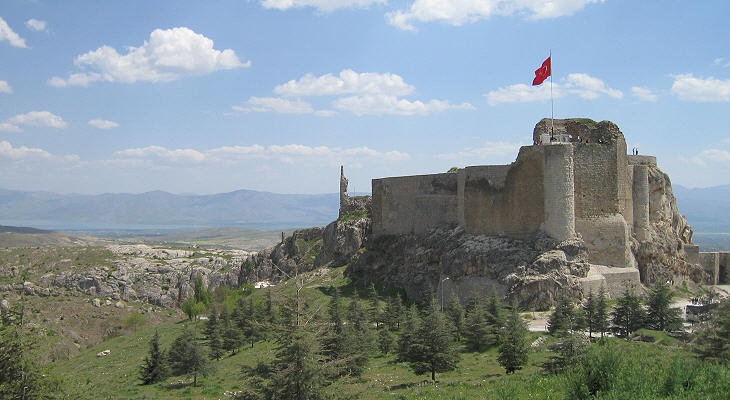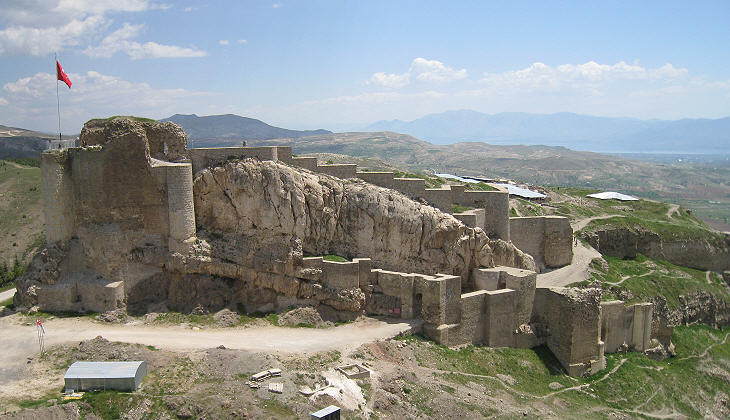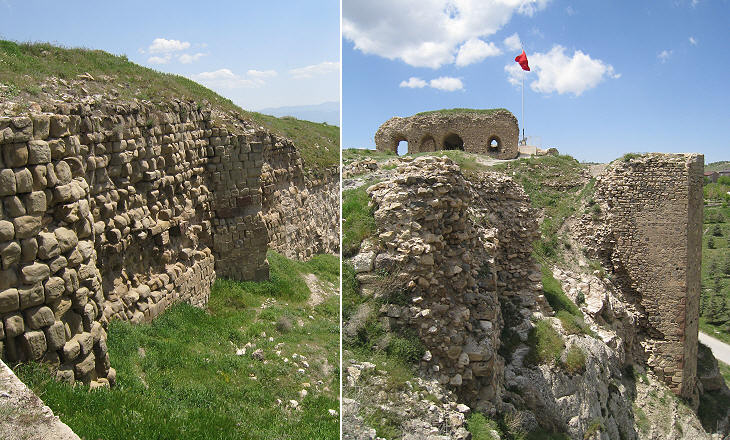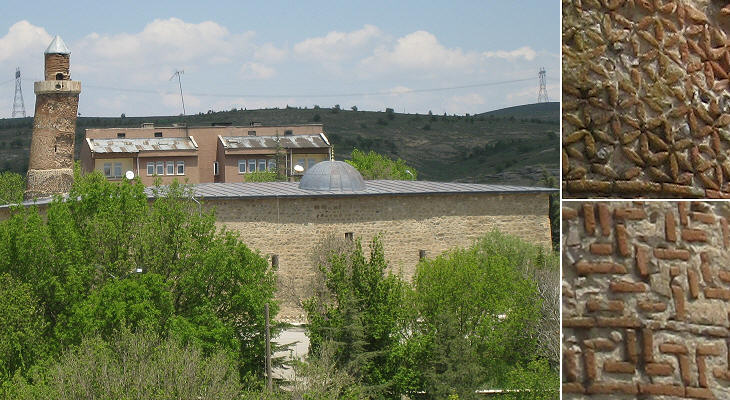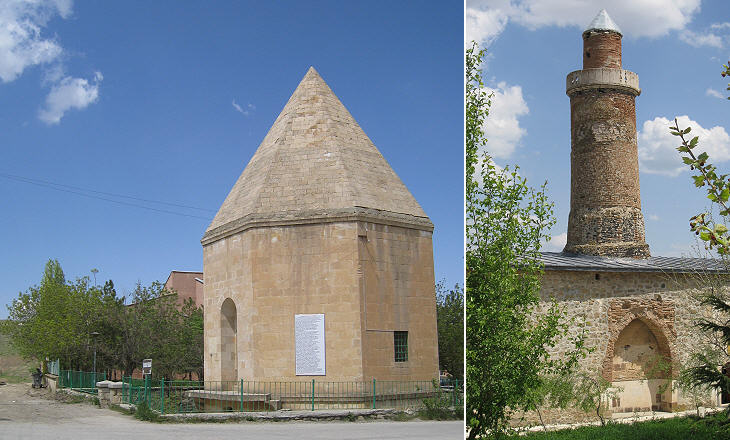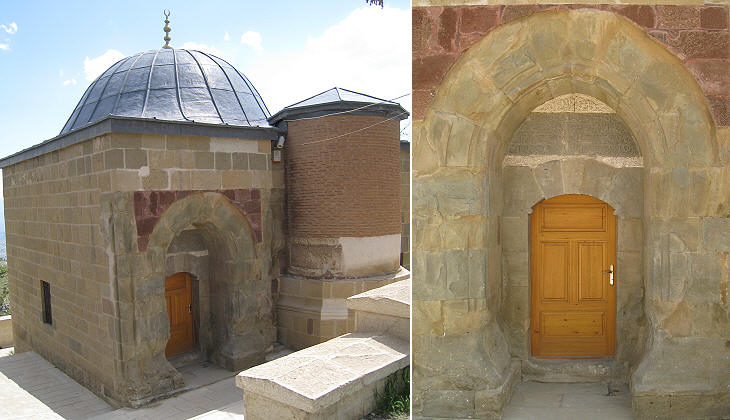  What's New! Detailed Sitemap All images © by Roberto Piperno, owner of the domain. Write to romapip@quipo.it. Text edited by Rosamie Moore. Page added in August 2009. |
 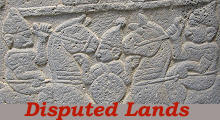 - Harput - Harput (relief at Karatepe) Harput is located in between the Euphrates and Tigris rivers, so its region could be most correctly called Mesopotamia (between the rivers), but from a geographical viewpoint the town is situated in the Anatolian tableland at an altitude of some 3,300 ft and it is not regarded as part of (Upper) Mesopotamia.
Today the landscape of eastern Turkey is characterized by many artificial lakes which were created by dams on its two rivers. Hazar Golu, a few miles south of Elazig, is an exception. It is a natural lake surrounded by mountains reaching 8,000 ft, which in mid May 2009 were still covered with some snow, an indication of the frigid winters of the tableland.
During the second half of the XIXth century most of the inhabitants of Harput migrated to a new town in the valley (today's Elazig); the migration was caused by scarcity of water supply, but also by conflicts among the various religious and ethnic communities living in the old town.
The isolated rock, upon which a castle was built later on, has been a fortified site since the IXth century BC. Harput was part of the Byzantine defensive system, but after the 1071 battle of Manzikert, the region was occupied by Turkish tribes. Harput became part of a small emirate ruled by the Cubuko who were vassals of the Sultanate of Rum; later on the town was occupied by the Artukids, who were based in Mardin and Diyarbakir; Harput was ruled by a separate branch of the Artukids and during this period, the town flourished and its main monuments were built. In 1234 Harput was annexed by the Sultans of Rum, but in 1243 the Mongol invasion weakened their power and the town was eventually included in Dulgadir, an emirate based in Maras.
In 1465 Harput fell to Uzun Hasan, leader of the Ak Koyunlu (White Sheep federation), Turkmen tribes to whom Timur had assigned the region of Diyarbakir; the Ak Koyunlu came in contact with the Ottomans and they tried in vain to prevent the (last) Byzantine Empire of Trebizond from falling into Ottoman hands; Uzun Hasan established relations with the Republic of Venice in order to contain the expansion of their common enemy. In 1473, at the battle of Otluk Beli, Sultan Mehmet II led his army to a great victory against the Ak Koyunlu: the battle showed that the Ottomans had an edge on their eastern enemies: they used cannon and rifles whereas Uzun Hasan mainly relied on light cavalry. Harput remained however in possession of the Ak Koyunlu; in 1507 it was occupied by the Safavids, who ruled over Persia from 1502 to 1722; their control of the town lasted only until 1516 when the Ottomans annexed Harput and the whole region; this occurred after the 1514 battle of Caldiran, in which Ottoman rifles and cannon exterminated the Safavid cavalry. Ak Koyunlu and Safavids regarded the use of cannon and rifles as dishonourable behaviour for a warrior.
Harput housed a large Armenian community who lived at the foot of the fortress; in the region several villages were inhabited almost entirely by Armenians; relations with the Muslim population were relatively good, because the Ottoman system of millet (religious community) granted the Armenians a certain degree of self government. The Armenians had no reason to support the Safavids, the only enemy the Ottomans had in the east, and they were loyal to the Sultan. The situation changed during the XIXth century: in 1827 during the course of a war with Persia, the Russians advanced south of the Caucasus and conquered Erivan in Eastern Armenia; soon after a war with the Ottoman Empire broke out; the Russians attacked on two fronts: along the Black Sea coast and from their newly acquired bases south of the Caucasus. The war was decided by the Russian advance towards Constantinople which forced the Sultan to sue for peace, but Russian forces entered Anatolia and conquered Kars and Erzurum. These were returned to the Ottomans by the peace treaty which ended the war, but the Sultan had to recognize Russian sovereignty over Eastern Armenia (which previously was a Persian possession). In the XVIIIth century the Russians had acted as patrons of the Greeks living in the Ottoman Empire, they now started to declare themselves protectors of the Armenians.
The Russian penetration in the Caucasus led to an early case of ethnic cleansing with large numbers of Muslims abandoning their homelands to start a new life in Anatolia; the move was in part fostered by appeals by the Sultans, who thought that in this way they weakened the Russian economy. The Ottoman government however did very little to help the refugees and many perished on their journey towards Turkey. These events stirred resentment against the Christian communities living in the Ottoman Empire; animosity against the Armenians increased after the 1877-78 war with Russia, when the Tsar placed his Caucasus army under the command of several generals of Armenian descent. In February 1878 the Russians occupied Kars and Erzurum. The intervention of Britain, France and Germany forced the Russians to mitigate the peace conditions they had imposed on the Sultan; the Russians retreated from Anatolia with the exception of Kars, which was annexed to their empire. In 1895 a massacre of Armenians at Harput was reported by the New York Times in the following article of November 17, 1895: The news of the massacre at Harput and the sacking of the mission premises there, is in some respects the most serious that has come from Turkey. Harput is a city of about 30,000 inhabitants in the centre of one of the largest plains of Eastern Turkey. It is the seat of Euphrates College and a centre of somewhat extensive missionary operations throughout the whole section. It has as a rule been a quiet city, not subject to the disturbances that have become more or less chronic in other places, and in the main Armenians and Turks have lived at peace. The American missionaries have always been on good terms with the Government, which has frequently sought their counsel in question of perplexity arising from the relations between Turks and Christians. They have also been on cordial terms with the Armenians of the old Church, so much so that they have joined in many services and have counselled together in public affairs. (..) Until a few days ago there was no indication of special danger when, not hearing from Harput, Minister Terrel telegraphed and received answer that the missionaries were alive but in great danger. Since then the blow has fallen. According to the telegrams from Sofia, Bulgaria, probably based on letters from Constantinople, there has been a massacre, and the American buildings have been sacked (..) the significance lies in the fact that the Turkish Government made no attempt to protect them. To suppose that the Armenians attacked them is nonsense. To suppose that the Moslems did, with the certain knowledge that they would meet the regular troops, is equally nonsense. Harput is the seat of a Mutessarif Pasha, and within an hour's ride there is a strong garrison perfectly capable of holding in check any number of men who sought to commit such a crime. That they did not is indicative of a purpose on the part of the Government to throw to the winds all promises of protection or reform. It makes more plainly true than ever that the central Government at Constantinople, even the Sultan himself, has not only connived at, but has directed the whole course of massacre.
Harput was eventually abandoned by almost all of its population; today its remaining buildings are scattered in the most peaceful rural environment; the inhabitants of Elazig come to Harput for their picnics, to take photos of the castle and to enjoy the view over their town. Ulu Cami, the main mosque, was built in the XIIth century; it had a tall minaret, which in part collapsed and was rebuilt in a leaning position. Its older part is decorated with fine brickwork. While it is true that a large part of Anatolia was conquered by the Arabs in the VIIth century, there is almost no evidence of the mosques they built, because the Byzantines destroyed them when they regained control of the region; this explains why Harput's Ulu Cami is one of the oldest mosques in the country.
A kumbet is a tomb with a high conical/pyramidal roof. They can be found in all the towns which belonged to the Sultanate of Rum. Harput is not very far from Divrigi, a town which has several kumbets.
Baba is a generic term of reverence for an elder of the town; Arap means Arab or darkly skinned; there is very little knowledge about who actually was the man for whom in 1279 Seljuk Sultan Kaykhusraw III built a small mausoleum and a mosque above it. To a large extent the building is a modern reconstruction, but it retains an elegant portal; unfortunately the stones used for it were too soft and they have lost their mouldings. Move to: Introductory page Tarsus Lampron Adana Sis (Kozan) Laiazzo (Yumurtalik) Karatepe Yilanli Kale Gaziantep Kahramanmaras Kilis Birecik Aleppo Cyrrhus Ain Dara Sanliurfa Harran Nemrut Dagi Diyarbakir Mardin Silvan and Malabadi Koprusu Map of Turkey with all the locations covered in this website  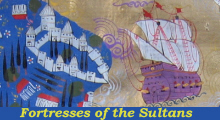  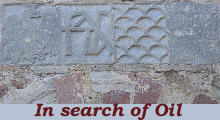 |
